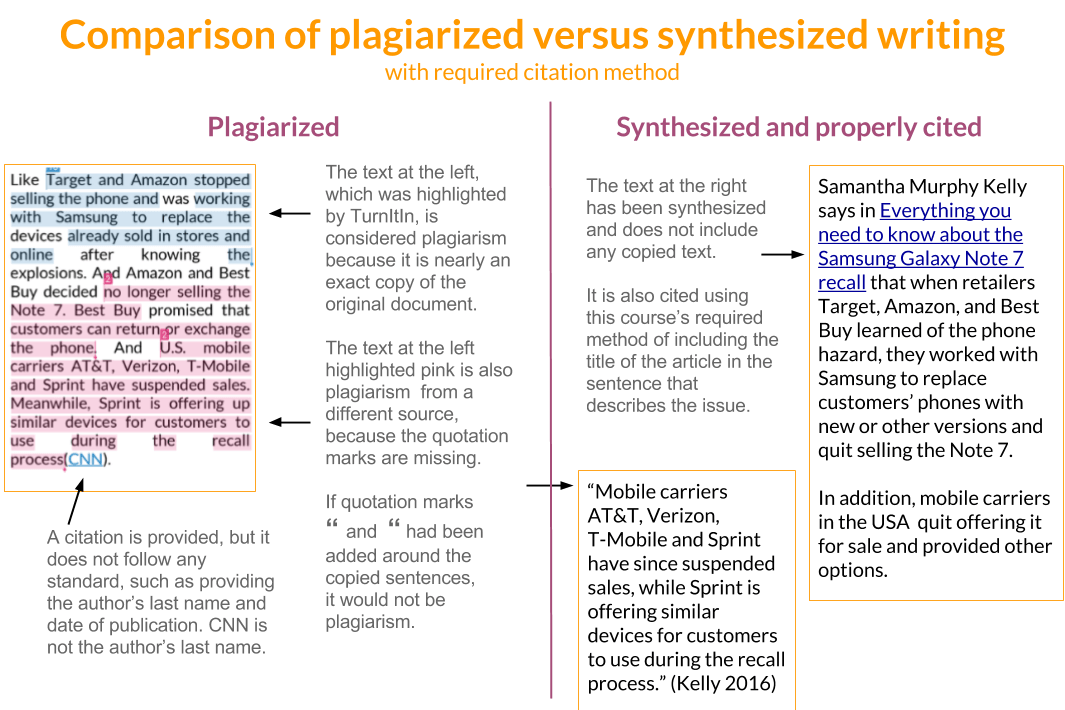Introduction
This textbook will undergo changes before the first day of class.
Choose a tab at the top to review important requirements and refer here often throughout the term to ensure you submit professional-level work.
Canvas Notifications
Your scores will be based on a Rubric for each Assignment and Discussion. So that you are notified immediately after scoring as well as receive my additional comments, set up the Canvas Notifications:
Allow Canvas to notify you via email when the Instructor, Teaching Assistant, or another student has sent you a message, comment, or discussion reply. From the Canvas Account area, click the Account or Profile button then Notifications link.
Activate all these options:
Due Date, Announcements, Grading, Submission Comment, Discussion Post, and Inbox Conversation.

Synthesis Writing Style
Much of the writing you'll do for this course is referred to as synthesis writing (one of the BACC Science and Technology Synthesis requirements).
Sandra Jamieson of Drew University reminds us in her On-Line Resources for Writers article that synthesis writing requires you go beyond just stating simple facts or quoting authors. It requires you to organize the compilation of facts, results, and ideas; report details from the sources using different phrases and sentences; and help readers understand the depth of events, studies, and concepts. (1999) Listen to the video about synthesis writing to fully understand what is required. →
Synthesizing Information © 2013 GCF Learn Free
Award-winning MIT brain researcher Ed Boyden reminds us How To Think...: "Synthesize new ideas constantly. Never read passively. Annotate, model, think, and synthesize while you read, even when you're reading what you conceive to be introductory stuff. That way, you will always aim towards understanding things at a resolution fine enough for you to be creative."
Educators who study Bloom's Taxonomy (Enokson 2010) use the concept of synthesis to explain the act of combining, changing, formulating, and reconstructing something. In this course, you'll use the facts and ideas from multiple sources to build cases for and against several ethical issues.
Explore Topics Collaborative Templates
Your weekly Exploration of Topics readings will be synthesized in the third-person style in a collaborative template that is prepopulated with instructions and writing prompts. The templates will be provided in Canvas Modules.
To use a template:
- Login to your OSU Google Account.
- Launch the weekly template from inside Canvas > Modules.
- Do not request permission to use the file. Login to your OSU Google Account.
- Do not copy the file.
- Notice that we're using a Google Slide presentation file rather than a word processing file. Each slide will be referred to as a page because we will be writing in formal research style (rather than watered-down phrases with little meaning).
- Read instructions on the cover page. When in doubt about how to write in the templates, refer back to this page for clarification.
- Notice the green instructions below each page.
Drag the notes pane up so you can read all of its text.
These are the reading/research and writing prompts that you must adhere to.
Be sure that you can read all of them before you begin the work so you don't miss any requirements.
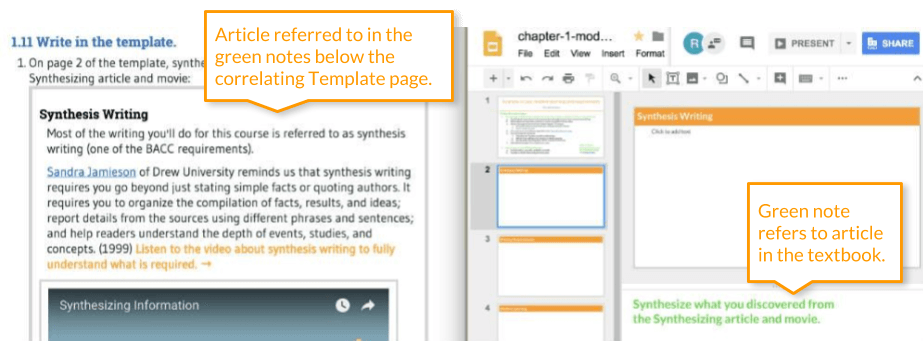
- Once you open the template, it will refer to articles or research you need to complete.
- Keep both the template and the articles open simultaneously.
- Most pages require research.
- The Bibliography page requires your references.
The weekly writing requires that you choose a reading for each major section, then synthesize what you read in your own words. Write as if you were writing a research paper; in essay format with lots of detail. Note who did what when, and why. The questions and search terms in the templates are meant to elicit in-depth, detailed accounts of what you've discovered, not short-answer, quiz-type responses. Write in a formal, professional research style. Write in a word processing document so you can check grammar and spelling. Write in default/normal style. Do not add style to the text. Write 250+ words (not counting the author and title of sources). Write in the third-person active voice to highlight studies and laws that prove your point. Only write in first-person if the instructions require it. Text of collaborations, discussions, and projects must be your original writing except for a few key quotes that are accompanied by a citation. Adhere to OSU policies.
- Write in the assigned Collaboration Document.
- Write in default/normal style. Do not add style to the text.
- Write 250+ words per topic (not counting the author and title).
- Write in the third-person active voice to highlight studies and laws that prove your point.
- Only write in first-person if the instructions require it.
In the following example, notice that the writing summarizes the details of one or more articles. The title of the article includes a hyperlink to facilitate launching them in new tabs.
Notice that it is written in the third-person active voice and is factual, rather than opinionated, unless otherwise requested.
These writing conventions are demonstrated in the screenshot below:
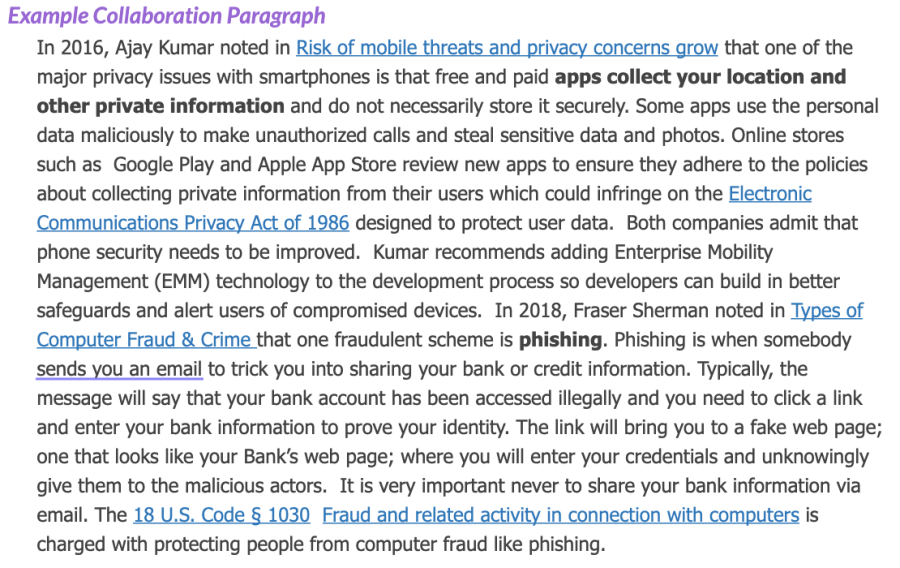
Case Examination Canvas Discussions
Discussions of cases will occur in Canvas. Specific prompts typically require research, citation, and at least one reply to another student's post that counters their analysis.
The case research discussion instructions found in each chapter will provide a list of cases to choose from, the research prompts and questions, and how to reply to your peers. The facts, definitions, milestones, and laws that you gather through research should be synthesized in your own words. Note who did what when, and why. Write as if you were writing a research paper; in essay format with lots of detail. Make paragraph breaks as per the instructions.
- Write at least 150 words per required paragraph in essay format, not bullet lists.
- Write to a global audience, not just US citizens. For example, instead of writing " we", describe which group, state, country, or culture you are writing about.
- Write in the third-person active voice style to highlight studies and laws that prove your point.
- Only write in the first-person style if the instructions require it.
- Grammar and spelling must be accurate.
- Edit your writing before submitting. Overly wordy and repetitious writing will not fit and may be marked down!
In the following example, notice that the writing synthesizes the details from one or more articles and laws. The title of each one includes a hyperlink to facilitate launching them in new tabs.
These writing conventions are demonstrated in the screenshot below:

Canvas Discussion useful features
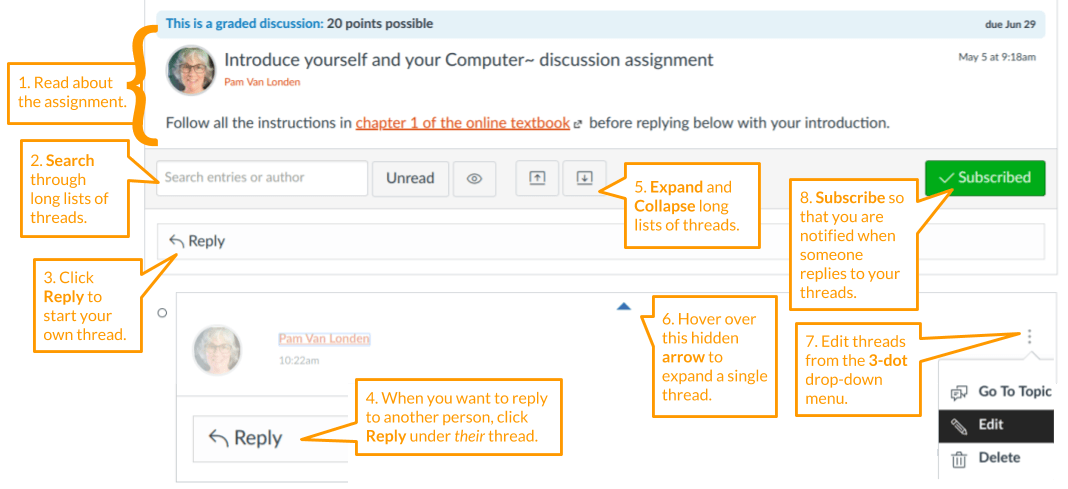
- At the top there is a set of Instructions and 3-dot more menu that displays the Rubric.
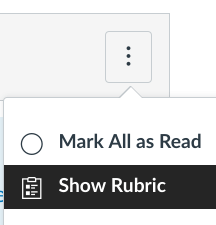
- The Search bar allows you to search for a keyword, key phrase, or student in the long list of threads (which will appear once others have posted).
- Below that, you'll see a Reply box. You'll click it to create a new thread where you can paste in writing, or write from scratch.
- When you want to reply to someone else's thread, use the Reply button under that student's thread, rather than the first one. This provides conversation continuity.
- Notice that you can collapse all of the threads to see the entire list of topics.
- Hover over the middle top of a single collapsed thread to use the expand arrow. This allows you to open just one thread at a time when they are all collapsed.
- Click the subscribe button to ensure you are notified via email that someone has replied to your thread(s).
When editing a thread, notice that you can:
- Make numbered or bulleted lists, add bold, italic, color, and text-wrapping. These features work when you have text selected.
- To hyperlink the title of an article, select the title, click the link icon, then paste the source's URL.
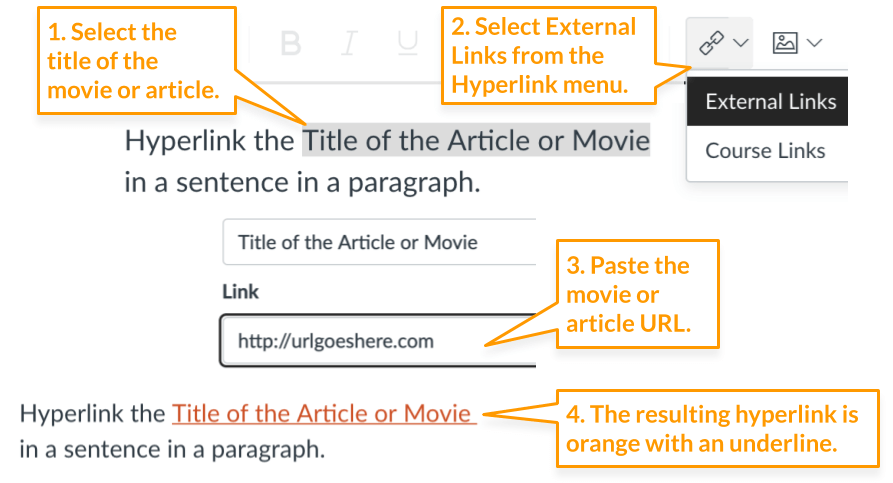
- Click the Insert Image icon, then choose Upload Image to insert a screenshot, diagram, or photo from your hard drive or a URL.
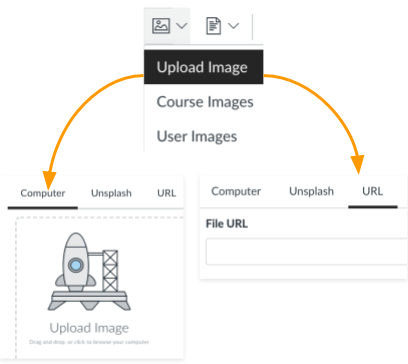
- To learn more, consult the Canvas Discussion tutorials: Canvas Student Guides for Discussions.
Citation Methods
To facilitate professional-level reading and discussion, cite each fact, study, statistic, law, and event using the style below. Hyperlinks in phrases or keywords instead of titles will lower your score.
| ➕ First use of a reference | ➕ Second use of the same reference | ✖ But not this |
|---|---|---|
|
➕ In 2016, Elle Hunt noted in Tay, Microsoft's AI chatbot, gets a crash course in racism from Twitter
that the tool became corrupt within 24 hours of interacting with Twitter feeds, which correlates with Godwin's Law.
Why is this style required? |
➕ "Tay in most cases was only repeating other users' inflammatory statements..."
(Hunt 2016)
Why is this style allowed? |
✖ This article said the tool became corrupt... ✖ The Guardian said the tool became corrupt... ✖ Elle Hunt said the tool became corrupt... ✖ The tool became corrupt... (Tay, Microsoft's AI chatbot, gets a crash course in racism from Twitter) ✖ "Tay in most cases was only repeating other users' inflammatory statements..." [#] Why aren't these styles allowed? |
Follow these requirements:
- Add hyperlinks to the Titles of Articles, Titles of Laws, court cases Griswold v. Connecticut, 1965, named statutes Named Act of 1974, or unnamed statutes 18 U.S.C. § 2258, so that readers can quickly open them in a new browser tab.
- The first time you reference a source, hyperlink the title. Thereafter, reference the author's name or pronoun (but only if you reference it again after some other source. There is no need to cite it after every sentence).
- Do not cite with superscript numbers and [#] or (author page).
- If you are discussing a website or organization, not an article, then embed the hyperlink in the proper name of that site, NOT the domain name.
- Instead of citing Wikipedia, cite the original article listed at the bottom of a Wikipedia page.
- No need to cite articles written by the instructor. Cite sources mentioned by the instructor.
- Add bibliographic entries to the Explore Topics file but not to the Examine a Case discussion.
Bibliography Tools
The following bibliographic tools will help you track and properly cite articles, images, and movies to use in each of the assignments. If you already use a tool you like, then you don't need to set up another one.
If you have never tracked sources with an app, you are required to try one of the following options. It will save you a lot of time!
Using an app will also keep your computer from crashing due to too many browser tabs being active simultaneously.
Choose one to set up:
- articleGoogle Docs
- Microsoft Word
-
 Chrome extension
Chrome extension -
 For Windows or Google
For Windows or Google -
 For MS Office
For MS Office -
 For MS Office
For MS Office -
 Online tool
Online tool -
 Online tool
Online tool
It doesn't matter which style you use for each bibliography (IEEE, MLA, APA, etc.) but each one must include: author last name, author first name, title, publisher, publication date, page number (optional), and the URL. Here is an example:
Desjardins, Jeff. "The Extraordinary Raw Materials In An Iphone 6S". Visual Capitalist. 2016. https://www.visualcapitalist.com/extraordinary-raw-materials-iphone-6s/.
Tips
- If a source does not have an author, use the title.
- If a source lacks a date, use the copyright date of the web page or publication (usually found in the footer).
- If a source is not online, then a URL is not required.
Illustration Requirements
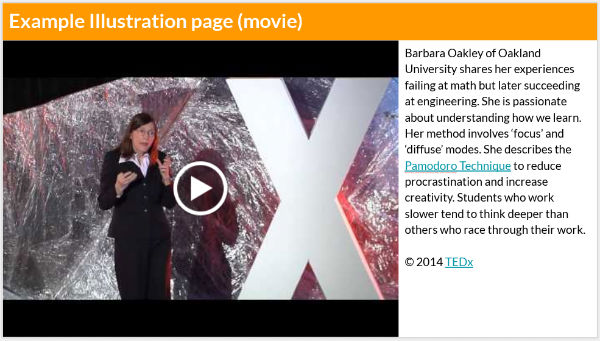
Some projects require the use of illustrations or movies. Only add what is required and no more. Use illustrative, supportive, detailed media, such as movies, charts, graphs, maps, or infographics.
- Generic, decorative pictures and logos will not earn points. Memes without text/description will not earn points.
- Use a full original paragraph to describe the media.
- Add the copyright statement provided by the owner of the media (not Google Images or YouTube): © year owner name. Example: © 2016 Samsung Group
- Hyperlink the copyright statement with the movie source URL and add it to the bibliography.
- Copyright dates can usually be found in the footer of the original website.
- Enlarge the media to fill the space provided in the template.
These illustrations are not informative:
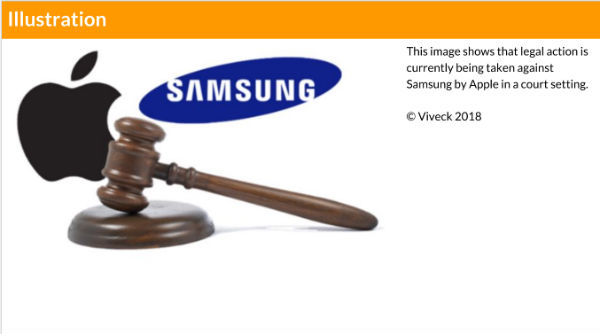
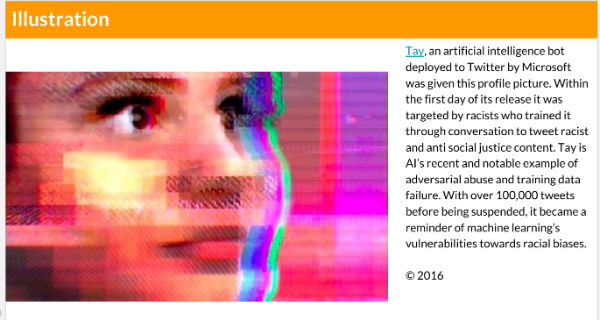
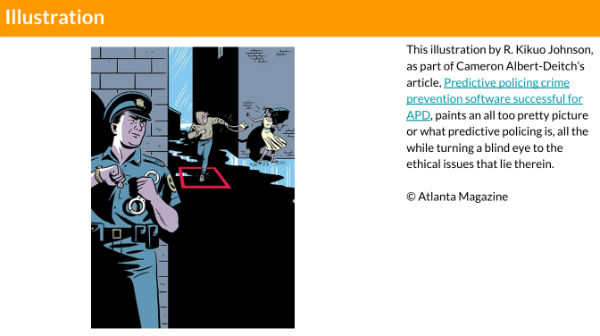
|
These illustrations are informative:

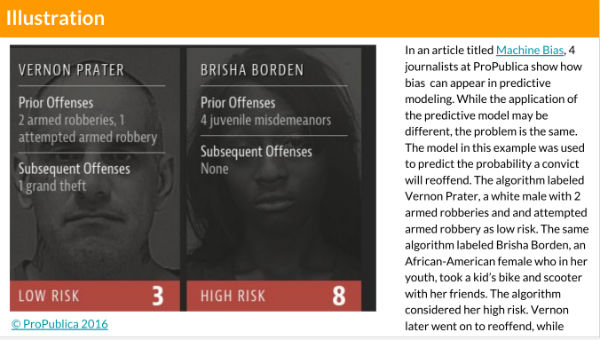

|
|---|
Avoiding Plagiarism
Text of collaborations, discussions, and projects must be your original writing except for a few key quotes that are accompanied by a citation. Adhere to OSU policies.
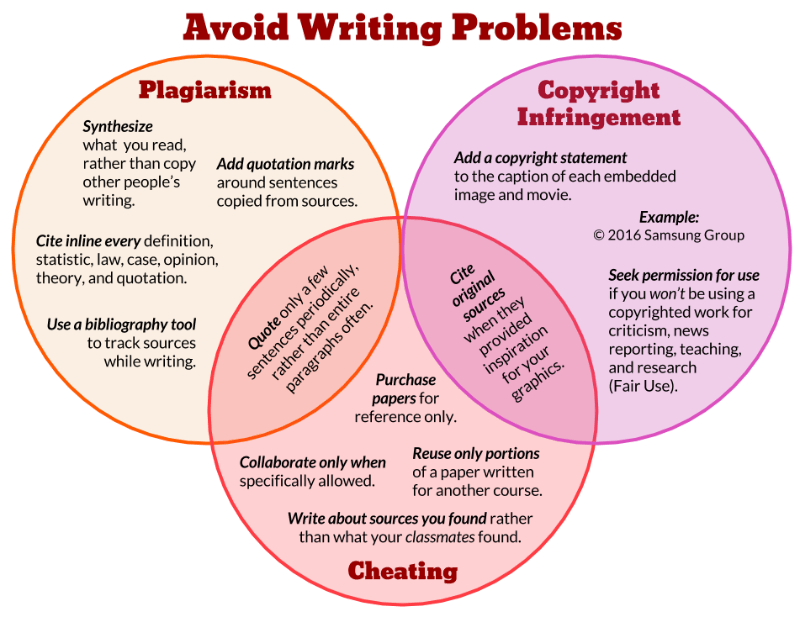
Avoid Writing Problems Diagram Transcript
- Plagiarism is defined as "copying words or ideas from someone else without giving credit". (TurnItIn 2017)
- Synthesize what you read, rather than copy other people’s writing.
- Add quotation marks around sentences copied from sources.
- Quote only a few sentences periodically, rather than entire paragraphs often.
- Cite inline every definition, statistic, law, case, opinion, theory, and quotation.
- Use a bibliography tool to track sources while writing.
- Copyright Infringement is defined as "reproduced, distributed, performed, publicly displayed, or made into a derivative work without the permission of the copyright owner." (USA Copyright Office 2017)
- Add a copyright statement to the caption of each embedded image and movie: Example: © 2016 Samsung Group
- Seek permission for use if you won’t be using a copyrighted work for criticism, news reporting, teaching, and research (Fair Use).
- Cite original sources when they provided inspiration for your graphics.
- Cheating is defined as the breaking of rules to avoid difficult work.
- Purchase papers for reference only.
- Reuse only portions of a paper written for another course.
- Collaborate only when specifically allowed.
- Write about sources you found rather than what your classmates found.
TurnItIn Originality Report

When you submit a PDF file to a Canvas Assignment, it will be loaded into TurnItIn's plagiarism checking system called the Originality or Similarity Report. Within a few minutes of submission, you should be able to see the report to confirm that you have not plagiarized.
Scoring: If you plagiarize a sentence or two, your score is reduced by up to 1 point. If you plagiarize several sentences or paragraphs on a page, then the entire page or paragraph earns a 0 score. If you plagiarize an entire document, then the score for the project is 0 and you get reported to the Writing Center for help and the Academic Integrity committee.
Follow these steps to ensure you do not plagiarize:
- If writing in Google Docs, use the Add-on menu to access the TurnItIn Draft Coach. Click the Similarity tab to run a report. Also run the Grammar tab report if you typically write poorly. Make corrections to render a clean report.
- After uploading an assignment to Canvas, click on the colored flag icon in the Grades or Assignment area to view the Originality Report.
Do not rely on the color of the flag or the percentage because it is misleading.

- You are expected to view it every time you submit and make corrections if necessary.
- You can ignore these kinds of highlighting:
- Instruction pages or Table of Contents.
- Page, slide, or section titles.
- Titles of articles or laws.
- Quoted phrases or sentences.
- Common phrases.
- Bibliography entries.
- Click a highlighted item to view detail about the source.
- If you see any actual plagiarism highlighted (see the Comparision below), you must revise your file and resubmit before the Due date.
